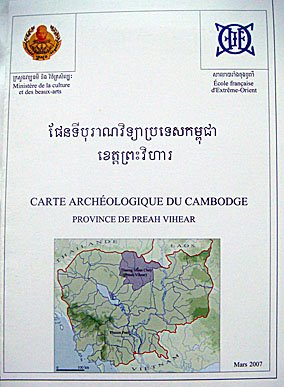Bruno and his maps
Speaking to Bruno Bruguier over lunch yesterday whetted my appetite for further adventures into the Cambodian countryside to unearth ancient archaeological sites that Bruno and his team have already identified on their Carte Archéologique du Cambodge maps, which cover all the provinces of the country where archaeological sites can be found. It was our first chance to meet up after many emails back and forth and Bruno is a man after my own heart. But of course he's the expert and I'm the complete amateur. He began his amazing project to map and record all of Cambodia's archaeological sites, before, during and after Angkor, in 1990 and is still going. Funds have dried up to expand the database as Bruno would like, so he is open to offers for funding to continue this invaluable work. He's registered over 4,000 sites, has another 1,000 that need to be finalized before they can be added to the maps and database and he knows there are still areas like the Cardamoms and Svay Rieng that have yet to be properly explored and documented. He hasn't done it alone of course, a small team has worked with him over the years to locate the main sites and then to widen the search on the ground with the help of local villagers. The maps themselves are a collaboration between EFEO (The French Institue of Oriental Studies) for whom Bruno works, when he's not teaching Khmer history at the Sorbonne in Paris, and the Ministry of Culture & Fine Arts. The maps have been published in both French and Khmer and are for sale at the National Museum and the French Cultural Center for $3 each. A corresponding interactive website, Carte Interactive des Sites Archéologiques Khmers (CISARK) with photos and additional information can be found here and though its mostly in French, Bruno is hoping to expand the languages to include English, Khmer and Japanese. But all this takes time and money, which is always in short supply. As an additional off-shoot of the project, Bruno and his wife have written six manuscripts of the major temples and archeological sites around Cambodia, on a regional basis. The first of those manuscripts, Southern Cambodia, has been made into a book by Reyum with many photographs and maps and is scheduled to be published at the end of January next year. The text will be in French because there was no funds available to translate it into English. If you haven't already guessed Bruno and his EFEO colleagues are all from France. It was a great pleasure to meet Bruno, I loved his natural enthusiasm for his work and I'm sure we'll remain in touch as I feed him any additional information I unearth.



0 Comments:
Post a Comment
<< Home